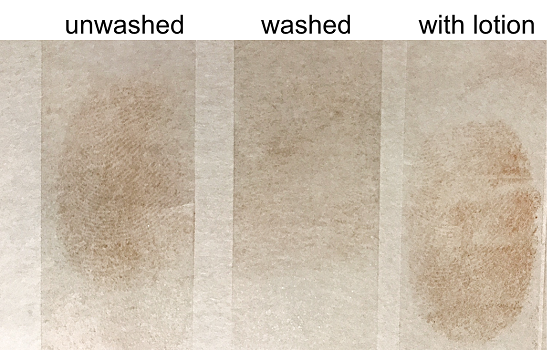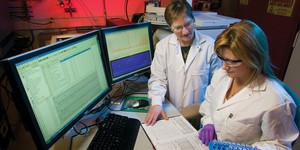Summary

Introduction
Do you know that on everything you touch, you leave fingerprints? If your hands are very dirty, this is obvious, because you can actually see them. But even if your hands seem clean, your fingerprints will stay behind on the surfaces you touch—they are just invisible! Do you want proof? Then make them visible in this activity and collect your own fingerprints!
Background
Detecting invisible fingerprints is an important task in forensic science, a branch of science that helps criminal investigations by collecting and analyzing evidence from crime scenes. Fingerprints are the most commonly-collected type of evidence. Because fingerprint patterns are unique to a specific person, they are a very reliable way of identifying a suspect. There are different types of fingerprints that can be left behind: 1) a fingerprint imprint in a soft surface, such as wax or soap; 2) a patent fingerprint, visible to the naked eye, such as fingerprints resulting from dirty hands; and 3) latent fingerprints, which are invisible, but still present.
These invisible latent fingerprints are made of water, fatty acids, amino acids, and triglycerides—in other words, they result from the oil and sweat that your skin produces naturally. To make them visible, you have to find a way to detect one of these substances present in the invisible fingerprint. The easiest method is called dusting, in which you use a very fine powder that can stick to the oil in the fingerprint. Once the fingerprint becomes visible, you can lift it from the surface with clear tape and transfer it to another surface to then take into the laboratory to analyze further. Other methods include using chemicals that react with the amino acids or water in the fingerprint; the chemical reaction results in a colored fingerprint, which you can then analyze easily.
Many factors determine the quality of a fingerprint on a surface. One of the most important factors is the surface texture. Fingerprints are most easily detected on smooth, non-textured, and dry surfaces. The rougher or more porous the material, the more difficult it will be to get good fingerprint evidence. Another factor is the condition of the skin on your fingertips. If it is very sweaty and oily, you are more likely to leave behind prints than if it is nice and clean. Of course, wearing gloves also prevents leaving behind fingerprints. Test it yourself and collect your own fingerprint evidence like a real crime scene investigator in this activity!
Materials
- Raw cacao powder
- Baby powder
- Small bowls (2)
- Clear tape
- Black paper
- White paper
- A glass or smooth metal surface
- A fine brush with soft bristles, such as a makeup brush
- Dust cloth
- Water
- Soap
- Hand lotion
Preparation
- Pour a little of the cacao powder into a small bowl.
- Pour a little of the baby powder into a small bowl.
- Wipe the smooth glass or metal surface that you are using for your experiment very thoroughly with the dust cloth.
Instructions
- Choose one finger of one of your hands and press it firmly onto the clean smooth surface. Remember where you put it on the surface. Can you see your fingerprint?
- If your fingerprint is on a dark surface, continue with the baby powder. If you have a light surface, continue with the cacao powder.
- Dip your brush carefully into the cacao or baby powder. Only the tips of the bristles should be covered with powder. Then, tap the brush to remove any excess powder.
- Sweep the brush carefully over the area where you put your fingerprint. Make sure to not apply too much pressure so that you do not wipe the print away. If necessary, add more powder to the brush, but be careful not to add too much. What happens if you apply the powder to the surface? Can you see a fingerprint developing?
- When you are done, gently blow off excess powder from the surface and check your result. Did you get a visible fingerprint? How well can you see the print? Can you make out the fingerprint pattern?
- Use a piece of clear tape and carefully press the tape down onto the surface on top of the developed fingerprint. Peel the tape off and transfer the fingerprint onto a piece of paper. If you used dark cacao powder, use white paper, and if you used baby powder, use a piece of black paper. Did you successfully transfer your fingerprint? Does it still look the same on the paper compared to your glass or metal surface?
- Wash your hands thoroughly with warm water and soap. Then, repeat steps 1–6 with the same finger you chose before. Did you get a fingerprint again? How does it look compared to the first one? Can you still see lots of details?
- Finally, apply some hand lotion and repeat steps 1–6 again. How does this fingerprint compare to the previous ones? Is it easier or more difficult to detect?
- Once you have transferred all your fingerprints onto a piece of paper, compare your results. Do they all look the same? Which one can you see the best, and which one the least? Can you explain your results?
Extra: Can you prevent leaving behind fingerprints on a smooth surface? What about wearing gloves? Repeat steps 1–6 of this activity, but this time, wear gloves. Can you still find a fingerprint on the glass or metal surface?
Extra: In this activity, you tested a nice, smooth glass or metal surface. Do you think other surface textures or materials will result in fingerprints as well? There is only one way to find out! Test other materials such as paper, textiles, or wood. How do fingerprints look on these surfaces?
Extra: Now that you are a professional in collecting fingerprints from surfaces, try to find them in your house! Where is the best place to look for them? Can you find your own ones or some from your family members and make them visible?
Observations and Results
Were you able to collect some of your own fingerprints? On a smooth surface like glass or metal, fingerprints tend to stick very well. With your unwashed hands, you should have been able to make your fingerprint visible with either cacao or baby powder. Just a little powder applied with a brush should be enough to reveal your fingerprint. If you apply too much powder, however, the fine details of your print tend to get lost. When you press too hard onto the surface with the brush, the fingerprint will be wiped away, so you have to be careful when treating the surface with the powder.
Your freshly-washed hands have much less oil and sweat on their skin as they have been washed away with the soap and water. This results in a much less pronounced fingerprint. You might have had difficulties in collecting this fingerprint or may not have found one at all. On the other hand, if you apply hand lotion, which contains lots of oil and fat, this will make your fingertips much stickier, which leads to a much more pronounced fingerprint. You should have seen a big fat fingerprint once you applied the powder to the surface where you put your finger. If you compare all the prints you collected, the one with hand lotion should be most visible, whereas the print with your washed hands should be barely visible.
If you did the extra activities, you might have noticed that porous or rough surfaces or materials such as paper or textiles are not very good for collecting fingerprints. Also, when wearing gloves, no fingerprints are left behind. These are all important factors that real crime scene investigators have to take into account when collecting fingerprints at a crime scene. Considering your results, where would you look for fingerprints in your home? Did you find some?
Ask an Expert
Cleanup
- Clean out your brush, wipe your fingerprinted surfaces with the dust cloth and dispose of the used baby powder and cacao powder in the trash.
Additional Resources
- A Simplified Guide to Fingerprint Analysis, from Forensic Sciences Simplified
- How does fingerprint powder work?, from Scientific American
- How do different surfaces affect the preservation of finger prints?, from UCSB ScienceLine
- Fingerprints give police new clues for solving crime, from BBC News
- Science Activities for All Ages!, from Science Buddies






